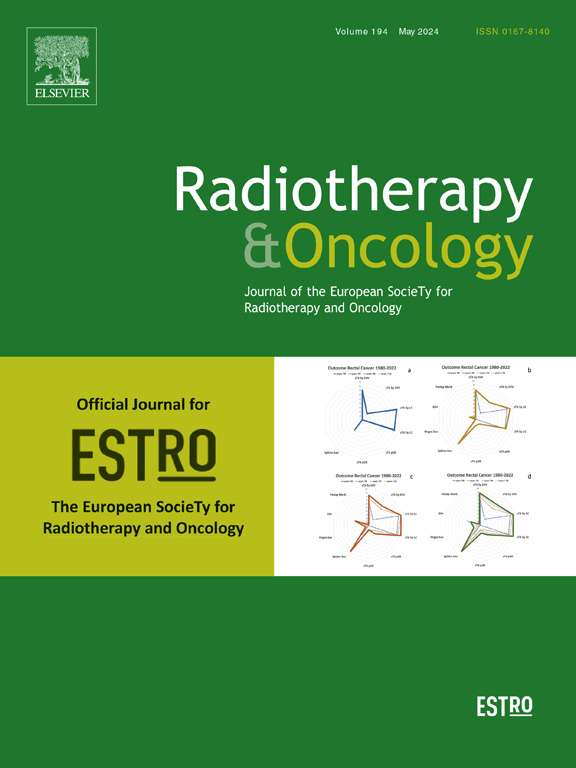Deep learning Radiopathomics based on pretreatment MRI and whole slide images for predicting overall survival in locally advanced nasopharyngeal carcinoma
IF 4.9
1区 医学
Q1 ONCOLOGY
引用次数: 0
Abstract
Purpose
To develop an integrative radiopathomic model based on deep learning to predict overall survival (OS) in locally advanced nasopharyngeal carcinoma (LANPC) patients.
Materials and methods
A cohort of 343 LANPC patients with pretreatment MRI and whole slide image (WSI) were randomly divided into training (n = 202), validation (n = 91), and external test (n = 50) sets. For WSIs, a self-attention mechanism was employed to assess the significance of different patches for the prognostic task, aggregating them into a WSI-level representation. For MRI, a multilayer perceptron was used to encode the extracted radiomic features, resulting in an MRI-level representation. These were combined in a multimodal fusion model to produce prognostic predictions. Model performances were evaluated using the concordance index (C-index), and Kaplan-Meier curves were employed for risk stratification. To enhance model interpretability, attention-based and Integrated Gradients techniques were applied to explain how WSIs and MRI features contribute to prognosis predictions.
Results
The radiopathomics model achieved high predictive accuracy in predicting the OS, with a C-index of 0.755 (95 % CI: 0.673–0.838) and 0.744 (95 % CI: 0.623–0.808) in the training and validation sets, respectively, outperforming single-modality models (radiomic signature: 0.636, 95 % CI: 0.584–0.688; deep pathomic signature: 0.736, 95 % CI: 0.684–0.810). In the external test, similar findings were observed for the predictive performance of the radiopathomics, radiomic signature, and deep pathomic signature, with their C-indices being 0.735, 0.626, and 0.660 respectively. The radiopathomics model effectively stratified patients into high- and low-risk groups (P < 0.001). Additionally, attention heatmaps revealed that high-attention regions corresponded with tumor areas in both risk groups.
Conclusion
The radiopathomics model holds promise for predicting clinical outcomes in LANPC patients, offering a potential tool for improving clinical decision-making.
基于预处理MRI和全切片图像的深度学习放射病理学预测局部晚期鼻咽癌的超生存期。
目的:建立一种基于深度学习的综合放射病理学模型来预测局部晚期鼻咽癌(LANPC)患者的总生存期(OS)。材料与方法:将343例经预处理MRI和全切片图像(WSI)的LANPC患者随机分为训练组(n = 202)、验证组(n = 91)和外部测试组(n = 50)。对于wsi,采用自注意机制来评估不同斑块对预后任务的重要性,并将其汇总为wsi水平表示。对于MRI,使用多层感知器对提取的放射学特征进行编码,从而得到MRI级别的表示。这些被结合在一个多模态融合模型中以产生预后预测。采用一致性指数(C-index)评价模型性能,采用Kaplan-Meier曲线进行风险分层。为了提高模型的可解释性,我们应用了基于注意力和集成梯度的技术来解释wsi和MRI特征如何有助于预测预后。结果:放射病理组学模型在预测OS方面具有较高的预测准确性,在训练集和验证集的c -指数分别为0.755(95 % CI: 0.673-0.838)和0.744(95 % CI: 0.623-0.808),优于单模态模型(放射组学特征:0.636,95 % CI: 0.584-0.688;深层病理特征:0.736,95 % CI: 0.684-0.810)。在外部测试中,放射病理组学、放射学特征和深部病理特征的预测效果相似,其c指数分别为0.735、0.626和0.660。放射病理学模型有效地将患者分为高危组和低危组(P < 0.001)。此外,注意热图显示,在两个风险组中,高度关注的区域与肿瘤区域相对应。结论:n:放射病理学模型有望预测LANPC患者的临床结果,为改善临床决策提供潜在的工具。
本文章由计算机程序翻译,如有差异,请以英文原文为准。
求助全文
约1分钟内获得全文
求助全文
来源期刊

Radiotherapy and Oncology
医学-核医学
CiteScore
10.30
自引率
10.50%
发文量
2445
审稿时长
45 days
期刊介绍:
Radiotherapy and Oncology publishes papers describing original research as well as review articles. It covers areas of interest relating to radiation oncology. This includes: clinical radiotherapy, combined modality treatment, translational studies, epidemiological outcomes, imaging, dosimetry, and radiation therapy planning, experimental work in radiobiology, chemobiology, hyperthermia and tumour biology, as well as data science in radiation oncology and physics aspects relevant to oncology.Papers on more general aspects of interest to the radiation oncologist including chemotherapy, surgery and immunology are also published.
 求助内容:
求助内容: 应助结果提醒方式:
应助结果提醒方式:


